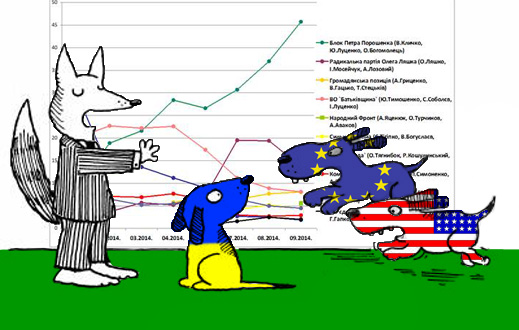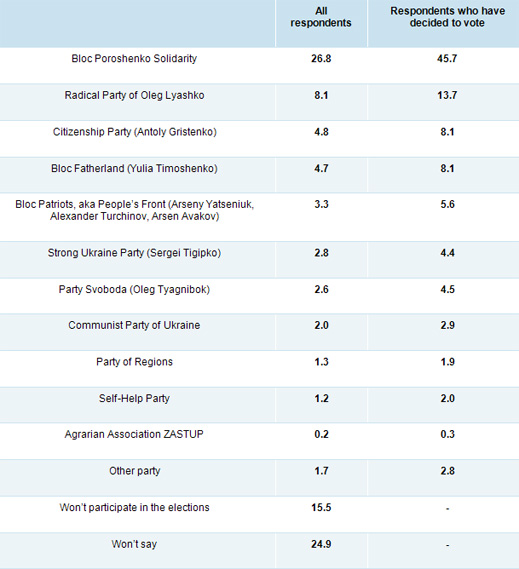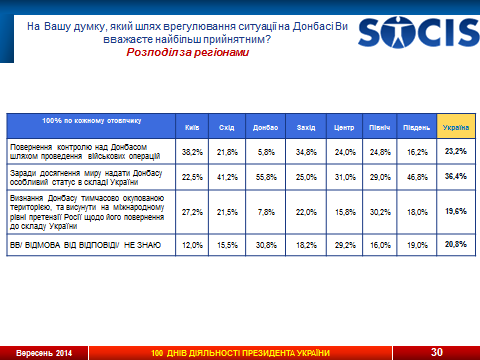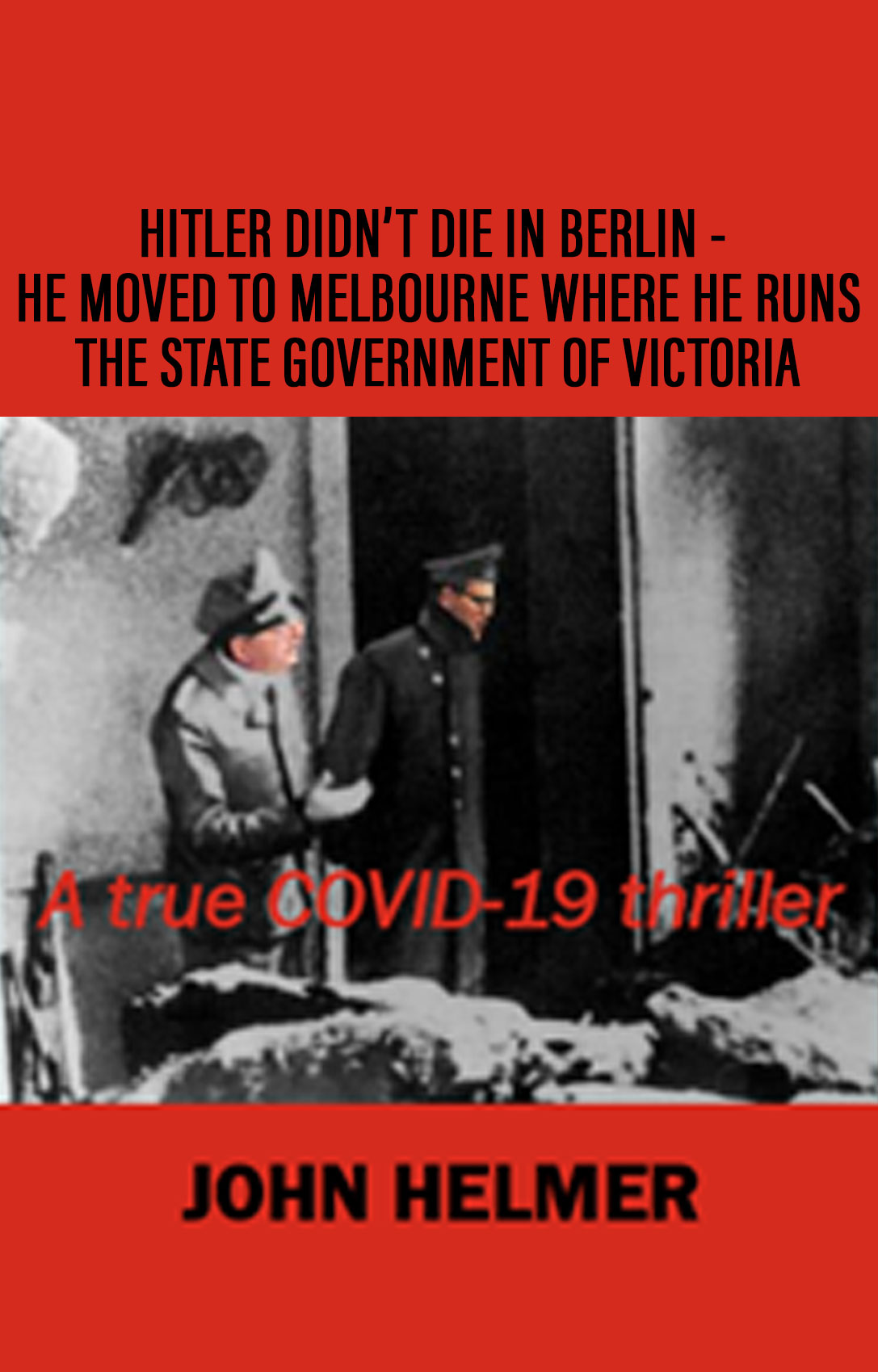
By John Helmer, Moscow
Polling of Ukrainian voters since the ceasefire in the civil war was negotiated on September 5 reveals that large, growing majorities of Ukrainians throughout the country are in favour of keeping to the ceasefire terms and stopping hostilities. The only political party Ukrainian voters say they support to do this is President Petro Poroshenko’s Solidarity bloc, an alliance with Vitaily Klitschko, Yury Lutsenko and Olga Bogomolets.
Ukrainian politicians, including the current Prime Minister Arseny Yatseniuk and former prime minister Yulia Timoshenko, are losing support, the voters say, because they favour war in the Donbass, sanctions against Russia, and military intervention of NATO on Ukrainian territory. Yatseniuk and Timoshenko are leading blocs they are calling Patriots of Ukraine and Fatherland in the campaign for parliamentary seats to be decided on October 26. On current polling trends, their voters across the country will number less than 5%, the threshold for winning party seats in the new Verkhovna Rada.
Also tested in last week’s polling are figures from western Ukraine, who have dominated the military and police ministries in Kiev until recently, and who are calling for NATO arms and US sanctions to fight Russia until President Vladimir Putin is toppled. They include Oleg Lyashko (below left) and his Radical Party; Oleg Tyagnibok’s (centre) Svoboda (“Freedom”), and Dmitry Yarosh’s (right) Pravy Sektor (“Right Sector”).

The new poll results show that voter support for them is evaporating since the ceasefire – in the case of Tyagnibok and Yarosh (Svoboda, Pravy Sektor) dwindling to single-digit numbers not larger than the pollster’s measure of statistical error. More than three-quarters of Ukrainian voters, including those who condemn the separatist movement in the Donbass, want a negotiated peace and end to war.
The latest polling has been conducted by the Centre for Social and Marketing Research (SOCIS) in Kiev. Polling by SOCIS ahead of the presidential election on May 25 can be re-read here. A second independent Ukrainian pollster, the Kyiv International Institute of Sociology (KIIS), reported on its survey of parliamentary party preferences two weeks before SOCIS, and can be read here. The KIIS poll sampled 2,040 respondents. The latest SOCIS survey covered 2,800 respondents across the country, except for the areas of fighting in Lugansk and Donetsk regions.
In a measure of general approval for Poroshenko’s performance as president, SOCIS reports that 46% register positive; 26%, negative; 24%, neutral. Asked how conditions in the country have changed for better or worse since Poroshenko’s election in May, 48.4% mentioned improvement in Ukraine’s relations with the US, 46% referred to improvement in relations with the EU. At the same time, 60% responded there has been no improvement in conditions of life. 24% said that corruption has become worse in the country since May.
Asked to identify the main priorities for Ukraine now, 49% opted for resolution of the conflict in Donbass; 38.5% said increased salaries and pensions; 36.6% picked control of inflation; and 33% put unemployment first.
In the SOCIS poll of voter preference, the Poroshenko bloc has more than a fourfold lead over its nearest competitor. Compared to the KIIS survey a fortnight earlier, the latest result shows a five-percentage point gain for Poroshenko among all respondents; and a near-9 point gain among decided voters.

Among the anti-Russian, war party figures, Lyashko’s Radical Party has already peaked and is now dropping, according to the SOCIS measurement. Since July Lyashko’s party preference has fallen by almost five points. Compared to the last KIIS poll at the start of this month, Lyashko’s support appears frozen.
Party preference for Yatseniuk, Timoshenko, and Tyagnibok is dwindling. The size of voter support for the extreme right parties – Svoboda, Pravy Sektor – has remained in the small single digits, so that declines are within the range of statistical error, but the direction is confirmed –their support too is shrinking, not growing.
TRAJECTORY OF PARTY SUPPORT, JANUARY TO SEPTEMBER 2014

Source: http://socis.kiev.ua/
SOCIS also attempted to measure how voters in different regions of the country are currently thinking about the outcome they favour for the civil war. The question asked was: “What do you think is the most appropriate way to resolve the situation in Donbass?” The following tabulation in Ukraine identifies three answers: the first is the war option, taking control of Donbass by military operations; the second is the peace option through granting special status to the Donbass; and the third option is to declare Donbass as occupied territory and seek international support for its return by Russia. The fourth response comprises those who said they were undecided or refused to say.

From left column to right the regional responses are reported from Kiev; the east; Donbass; west; central regions; north; south; and all-Ukraine.
Overall, voter preference for continuing the war is just 23.2%, with 38.2% in favour in Kiev; 34.8% in the western areas of the country; and just 5.8% in Donbass itself. Voters in favour of a peace settlement with special status for Donbass are more numerous, totalling 36.4%. Support for this option is greatest in Donbass (55.8%); 46.8% in the south; and 41.2% in the east. Least support for the peace option is registered in Kiev (22.5%) and the west (22%).
As for the 20.8% of the uncommitted or undecided voters overall, 30.8% are in Donbass; 29.2% in the central regions. In the parts of the country still keenest on war, the proportion of voters surveyed who aren’t sure is not less than 12% (Kiev) and as many as 19% (south). Even in the Catholic, Ukrainian-speaking western regions, almost one voter in five isn’t sure what outcome would be best. The strongest conviction that the war is paying off and worth continuing is concentrated in Kiev.











Leave a Reply